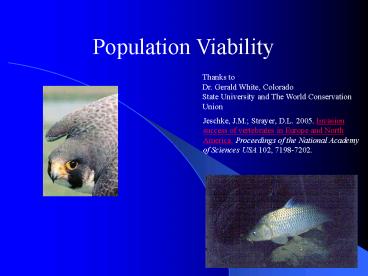Population Viability - PowerPoint PPT Presentation
1 / 18
Title:
Population Viability
Description:
Proceedings of the National Academy of Sciences USA ... Orca Population. 10. 30. 20. 50. 40. 80. 70. 110. 90. 60. 100. Time (years) 40. 60. 80. 100. 120. 140 ... – PowerPoint PPT presentation
Number of Views:106
Avg rating:3.0/5.0
Title: Population Viability
1
Population Viability
Thanks to Dr. Gerald White, Colorado State
University and The World Conservation Union
Jeschke, J.M. Strayer, D.L. 2005. Invasion
success of vertebrates in Europe and North
America. Proceedings of the National Academy of
Sciences USA 102, 7198-7202.
2
Definition
- Probability of going extinct
- Time frame
- Initial population size
3
Determining Viability of a Population
- Population Viability Analysis (PVA)
- Minimum Viable Population (MVP)
4
Population Persistence
- Connected habitats are better than disjointed
habitats
- Suitable habitats in close proximity to one
another - are better than widely separated habitats
5
Population Persistence
- Populations with higher reproductive rates are
more - secure than those with lower reproductive rates
- Environmental conditions that reduce carrying
- capacity or increase variance in the growth rates
of - of populations decrease persistence probabilities
- Late stages of succession are more likely to have
- persistent species
6
Simulation of most plausible model. Medians and
95 confidence interval of predicted population
sizes
110
100
90
80
70
Orca Population
60
50
40
30
20
10
40
60
80
100
120
140
160
20
Time (years)
7
Sources of Variation
- Process variation
- Demographic
- Sampling variation
8
Exotic, Invasive, Alien, Non-indigenous, or
Nuisance Species
9
Source
- Domestication of animals
- Associated parasites and disease
- Migration of humans with their entourage
- Commerce
- Habitat destruction
10
Probability of Success
- Niche Concept
- Limiting Similarity
11
How can introduced species alter community
structure?
- Competition
- Parasites
- Predator-prey
- Hybridization
- Adaptation
12
Conventional Wisdom
Current Research
One in 4 imported vertebrates becomes invasive
13
(No Transcript)
14
- Invasive species are among the most
- dramatic ways humans are changing
- the planet
- The combined effect of the spread of
- non-natives and the extinction of native
- species is making the worlds ecosystems
- more and more alike in other words, more
- homogenized.
15
What are they worth ?
16
Some Empirical Rules
1. Most invaders fail
2. Most successful invasions dont extirpate
native species.
3. All systems are invasible
4. Major impacts seen when number of native
species is low
17
5. Intermediate human disturbance makes systems
vulnerable
6. Long term invaders will be most likely to
succeed in systems that best match their
requirements
7. Invasions are much more likely to succeed if
native species have been depleted
18
8. Success of invasion directly related to
amount of human alteration
9. Invasion least likely in highly variable or
unpredictable environments
10. Native species most likely to be replaced in
either unstressed or seriously stressed systems































